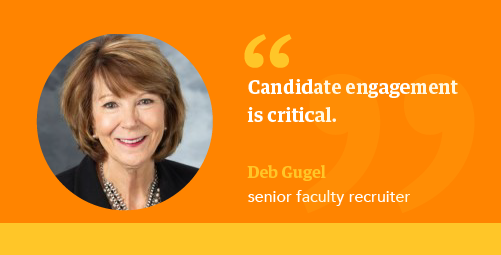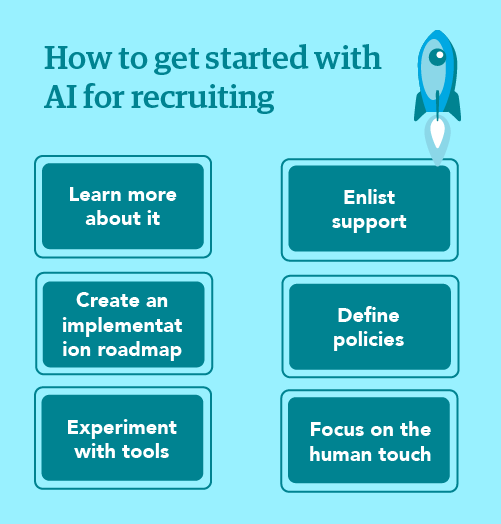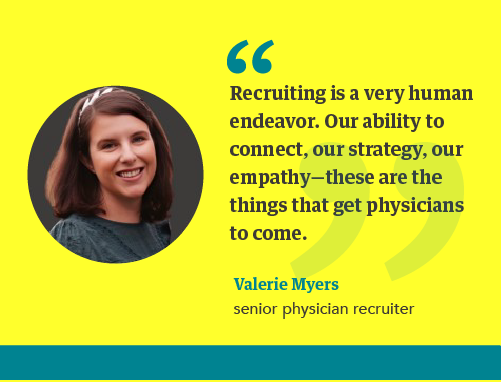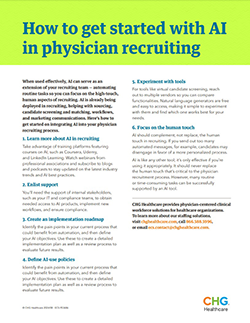
Physician recruiters, who are always stretched thin, are finding ways to extend their reach with artificial intelligence (AI) tools. This burgeoning field has the potential to automate repetitive tasks, efficiently customize communications, and supercharge data analytics. However, recruiting is a highly personal process, and AI cannot replace the human touch. When used most effectively, AI acts as an extension of your recruiting team, streamlining workflows to enable you to focus on the high-touch, human aspects of recruiting.
When most people think of AI, they think of natural language processing platforms like ChatGPT, Google’s Gemini, or Microsoft Copilot. Yet AI encompasses many forms of computer-enhanced problem-solving, including:
- Chatbots
- Image generation
- Data visualization
- Speech recognition
- Virtual assistants
- Conversational AI (like Alexa and Siri)
In this guide, we’ll explore:
- The various ways AI is being used in physician recruiting
- The risks of relying on AI in recruiting
- Finding the balance between AI and the human touch
- Important diversity, equity, and inclusion (DEI) considerations
- How to get started with AI for recruiting
How AI is being used in recruiting today
With the breadth of available AI tools, it’s no surprise that AI is already being deployed in a variety of ways, from candidate sourcing and screening to marketing and communications.

Passive candidate sourcing
Passive candidates are individuals who are not actively seeking employment but who may have precisely the skills and experience you’re looking for. Typically, finding these candidates involves hours of searching websites and social media platforms. AI tools can automate this drudge work by using your specifications to search multiple online sources and then automatically reach out to possible candidates with personalized messages.
Resume screening
AI resume screening tools are increasingly being integrated into applicant tracking systems. Such tools use algorithms to score and eliminate candidates based on keywords from the job description. The promise of AI resume screening is that it can automate a time-consuming task. The potential downside is that qualified candidates who don’t use exactly the right keywords could be overlooked. Plus, using keywords alone doesn’t always take into consideration the complexity of patient care; a human reviewer can understand context and experience better than current AI tools.
Virtual recruiter screening
A virtual recruiter goes a step beyond resume screening by automatically engaging with candidates to qualify them for open positions. These tools can send personalized messages to candidates via email, phone, or text to initiate screening conversations about topics like work history, certifications, current location, and salary requirements. The screening results are then summarized and shared with recruiters.
Candidate matching
With candidate matching, applicants are filtered into job opportunities in your database. These tools compare resumes against every opening in the system to find opportunities that may be a better fit.
Activating workflows
AI tools can smooth recruiting processes by automatically triggering workflow actions like email confirmations, updating the ATS database, and sending onboarding documents. These tools can even automate interview scheduling — a notoriously difficult pain point in the recruiting process.
Marketing and communications
Language processing platforms have become invaluable assistants for recruiters, who are using them to draft job postings, emails, surveys, and other communications.
Large language models can help in a variety of ways:
- Proofreading
- Making text more engaging
- Summarizing large documents
- Suggesting headlines, calls to action, email subject lines, etc.
- Creating variations targeted to different audiences
- Drafting survey questions
The risks of using AI in physician recruiting
There’s a great deal of optimism surrounding the potential of AI to ease physician recruiter workloads and smooth recruitment processes. However, recruiters should be aware of the risks that come with AI as well.
Recruitment relies on building personal connections. But too many un-personalized, automated messages could leave candidates wondering if any humans are involved in the process at all and risk candidates disengaging with the process in favor of one that feels more personal. “It’s going to feel like that cold call, that sales kind of thing, where you’re not communicating for connection. You’re just getting the message out to as many people as possible,” explains Valerie Myers, senior physician recruiter – FL division, for Conviva & CenterWell Senior Primary Care.
“Candidate engagement is critical,” says Deb Gugel, faculty recruiter for the University of Wisconsin School of Medicine and Public Health’s Department of Medicine. “Ghosting is a real issue. It is easier to say no to an automated message.”

Inherent AI biases are another concern for many recruiters. “We're not screening resumes via AI yet for a number of reasons,” Myers says. “As these models are being used more and more, they're creating their own biases, and we don't want to, in any way, do something that wouldn't be compliant or fair from a DEI standpoint.”
Heather Spinney, talent acquisition and provider recruiter for Northeastern Vermont Regional Hospital, is another recruiter who’s not yet using AI to screen resumes. She’s concerned that in some ways AI can be too objective and filter out candidates that actually would be a good fit. “I think it would pass on a lot of people, because applicants make mistakes on their resumes. I don't think AI knows enough about what I'm looking for and can see those opportunities,” she says.
Create efficiencies: Five strategies for optimizing your healthcare workforce
Finding the balance between human and AI
Despite the challenges and risks of AI, “I'm excited about the ways that it can actually improve human connection,” Myers says.
Tamiko L. Stanley, chief diversity equity inclusion officer and managing partner with Elite Executive Strategies, says a good way to find the balance between AI and human connection is to identify the recruiting tasks or processes that add the most value to your outcomes. “Pick the top two or three you must maintain for that personal connection. For example, what has been the most valuable personal touch or connection when you have target-recruited individuals for a particular specialty or department?” she says.
“When I can use AI for things like coming up with email subject lines, generating responses, or proofreading, then I have more time to actually connect with people — to pick up the phone when I might have sent an email. Now I have extra time to make that phone call,” says Myers.

Gugel says her organization’s applicant tracking system has auto-response capabilities, but she prefers to reserve that task for more personalized communication. “I have a communication template that makes it almost automated, but then I can customize it: ‘You say you'll be finishing your training in 2025. Why are you looking now?’”
As Gugel points out, reviewing and revising AI-generated content can make it more targeted and relevant, helping to avoid creating a cold, impersonal experience for candidates.
DEI and the risks of AI
In every industry, a focus on DEI can promote a culture that enables everyone to contribute and succeed. But DEI is crucial in healthcare for additional, unique reasons.
“What we see in our country is people of color having poorer health outcomes than their non-diverse counterparts. When we talk about root-cause analysis, a lot of it goes toward the lack of diverse minds, diverse physicians, diverse leaders in the room when healthcare policies and procedures are being made,” Stanley explains. “Recruiting diverse physicians is directly tied to having equitable health outcomes.”

Bringing AI into recruiting workflows can have mixed results when recruiting for diversity. AI should be used with care and equitable intentions. When known biases are considered and accounted for, there is some potential for AI to help mitigate the impact of human bias. However, AI can also amplify biases it has absorbed from the data it was trained on. “AI will be biased because our society's information is biased. That is the reality we're in,” Stanley says.
Keeping inclusion in mind at every AI touchpoint in the recruiting process can help lower risks to DEI. For example, when using AI to create job descriptions, candidate communications, or other marketing materials, ensure your prompts explicitly ask for inclusive and equitable language, and always be sure to carefully review the material before posting or sending it on.
Diversify your team: Questions to help healthcare facilities focus on diversity and inclusion
“This goes beyond communication,” Gugel says. “It’s critical to source candidates from marginalized communities as well.” Directing AI to search for more diverse candidates allows recruiters to cast a wider net. “This is a complicated process, but AI could be part of the solution,” she says.
Setting goals for diverse hires can help you hold yourself accountable when using AI. Stanley suggests setting goals around the diversity of your applicant pool and what percentage of diverse hires you achieve over a specific timeframe. “If you set goals that are tied to how you evaluate your overall performance, you'll be able to make sure the AI you're using on the front end is going to support your desired outcomes,” she says.
Stanley also recommends developing an assessment tool — a scorecard — to evaluate results from using AI. “Maybe have that scorecard live outside the recruiter role — maybe in HR or analytics or compliance,” she says. “So, you have the scorecard that's helping you identify whether or not your technology is supporting your DEI goals, but it's not the burden of doing your own measurements and metrics.”
Fight against bias: How to strengthen diversity in your healthcare workplace
How to get started with AI
Diving into AI can feel overwhelming, especially with so many new tools and platforms entering the market nearly every day. Here’s a step-by-step approach to getting started.

1. Learn more about it
Many resources exist that can help you gain a baseline knowledge of AI. Platforms like Coursera, Udemy, and LinkedIn Learning offer courses, some of them specifically tailored to using AI for recruiting. Many professional associations and AI vendors have developed informative webinars. Additionally, you can subscribe to blogs and podcasts created by industry experts to stay updated on the latest trends and solutions.
2. Enlist support
Since some organizations have blocked access to AI platforms, you’ll need to garner support from internal stakeholders, including hiring managers, HR, compliance teams, and IT. Each of those touchpoints will have some input into how AI can be used in your organization and can help you build a case for how AI will be used and why it will be helpful to your process.
3. Create an implementation roadmap
A road map will help ensure you’ve examined all the angles before implementing AI processes and technologies. First, you’ll need to thoroughly detail your current recruitment processes to identify the pain points that AI may be able to alleviate and look for opportunities for improvement. Then, you can define your AI objectives, such as improving candidate sourcing or reducing time to hire. Next, create a detailed implementation plan that considers timeline, resources, and stakeholder responsibilities. Finally, introduce a thorough and ongoing review process to evaluate results critically.
4. Define policies
AI comes with inherent risks. For recruiting, AI risks include a poor candidate experience, losing the human touch, amplification of bias, and threats to your organization’s reputation. For that reason, setting some ground rules or establishing a code of AI ethics is crucial.
“It’s giving people the knowledge and the training of the pitfalls of, for example, when you add in certain data or when you rely on AI without some kind of backup or review. It's a tricky line for sure, and we need to make sure that whatever we're doing is in the best interest of the candidates and the practices that we're representing,” Myers says.
Be sure to familiarize yourself with any AI-related policies your organization may already follow. If you need to create them from scratch, there are many resources to help you get started.
5. Experiment with tools
If you’re looking for a recruiting technology like virtual candidate screening, for example, reach out to multiple vendors for product demonstrations so you can compare functionalities. On the other hand, natural language tools are free and easy to access, making it simple to experiment with and discover which one works best for your needs.
“For me, it was just a bunch of trial and error,” Spinney says. “The more you use it, the more comfortable you are with it.”
“The hardest thing is figuring out how to build out a prompt to get what you want,” Myers says. “Instead of one option, ask it for five or 10. Give me 10 email subject lines … now you're narrowing in on something and then being able to refine it.”
You can also refine style and tone, she explains. “If it’s too casual, you say, ‘Edit these into a more professional tone.’ If it’s too professional, ‘Make this a friendlier tone.’”
Gugel recommends consulting with other recruiters and sourcing specialists on how they are using AI. “Ask them what has worked, what pitfalls to avoid, and for any other insights they might have,” she says. “Reaching out to others can shorten your learning curve.”
Think outside the box: Six creative ways to overcome staffing challenges
6. Focus on the human touch
It’s worth emphasizing that AI should complement, not replace, the human touch in recruiting. “AI doesn’t have the problem-solving and critical thinking ability that a recruiter provides,” Gugel says.
“Recruiting is a very human endeavor. If all you needed was a good message in a job post, we wouldn't need recruiters,” Myers says. “Our ability to connect, our strategy, our empathy—these are the things that get physicians to come who wouldn't have just because the job description is posted somewhere.”

In summary, AI tools are like any other tool; they are only effective if you are using them correctly, and they should never replace the human touch that is critical to the physician recruitment process. On the other hand, many straightforward but time-consuming tasks in recruiting could be successfully offloaded to an AI tool. In essence, AI can become a personal assistant who helps you communicate the way that you want to.
Click the image below to download a one-page summary of this article:

CHG Healthcare can help you find the doctors, nurses, and allied professionals you need to staff your facility. To learn more about our staffing solutions, give us a call at 866.588.5996 or email ecs.contact@chghealthcare.com.